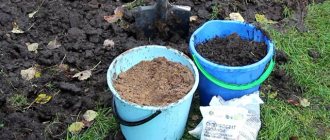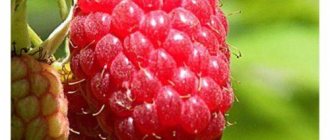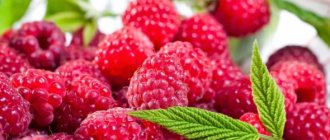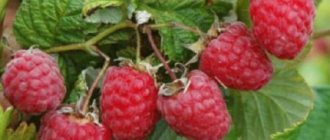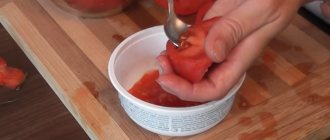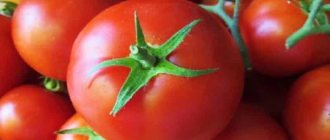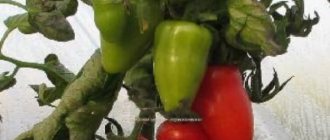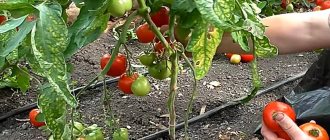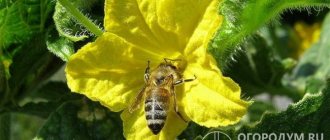Harvesting and storage
Gardening rules recommend picking raspberry fruits early in the morning.
Only mature fruits that can be easily separated from the fruit can be harvested. The berry is taken with 3 fingers and, without squeezing, with a slight turn it is separated from the fruit. Sometimes the berries are collected together with it, which complicates the picking process, but significantly improves the berries’ ability to be stored and transported. The berries are collected in booties, which, after filling, are placed in cardboard or plastic boxes of 8–12 pieces each.
Important! It is extremely undesirable to pick berries if there is dew or residue from previous rain on them, as this radically reduces the shelf life of the berries.
The optimal humidity for storing raspberries is 90–95%. At lower humidity, the fruits lose turgor, the shelf life is sharply reduced along with transportability. To keep humidity at the optimal level, raspberry-filled booties are wrapped in perforated stretch film or installed next to air humidifiers. At a temperature of 0...+2°C, raspberries can be stored for up to 2–4 days. If they were collected in dry and cool weather in the fall, then the shelf life can last up to a week.
How to collect and preserve the harvest
The first berries of the Eurasia raspberry begin to ripen by the end of July and by the first cold weather the variety completely completes the fruiting cycle. Ripe berries stay on the branches all week, without losing at all their attractive appearance and portability. One bush can bear about five kilograms or more of magnificent large fruits during the season.
Raspberries of the Eurasia variety bring rich harvests from one bush - from 5 kg or more
Raspberry picking should be done in the morning or evening and only in dry weather. If there was dew in the morning or it rained just before, it is better to wait until the berries dry out. Wet fruits will begin to spoil quickly.
If raspberries are collected for subsequent processing, they can be safely picked from the bush without a tail. However, if the berries are intended for storage or sale, then it is better not to separate the berries from the stalk. To prevent raspberries from becoming crushed, they are immediately placed in a container or container for transportation or storage.
At a temperature of 20 degrees, Eurasia raspberries can last up to 3 days. However, provided that it was picked with the stalk and placed in 1 or 2 layers on a wide dish. The layers must first be covered with soft paper. Will keep in the refrigerator all week. And freezing will make it possible to increase the shelf life by a couple of months.
At a temperature of 20 degrees, Eurasian berries can last up to 3 days
Healthy raspberries are best consumed fresh. The remontant variety itself contributes to this, because the harvest does not ripen immediately, and its harvest lasts for a couple of months. The generous harvest of Eurasia raspberries also allows you to stock up on tasty and healthy preparations for the winter. Jam, jam, confiture, juices and much more can be prepared from a multifunctional variety.
And dried raspberries, their leaves and flowers are successfully used in alternative medicine.
Basic rules of care
Basic rules for caring for remontant Polka raspberries include fertilizing, pruning, watering, loosening, tying, and shelter for the winter. The more carefully the rules of care are followed, the larger and better the harvest.
Top dressing
The Polka variety needs abundant feeding. For full development and high yields, the plant requires a large amount of nutrients. If they are in insufficient quantities, the raspberries weaken, the quality of the fruit deteriorates, and ultimately the soil under the bushes will be depleted and the plantings will die. To prevent this from happening, Polka needs to be fueled almost the entire season.
In the spring, as soon as the plants begin to grow, apply dry complex fertilizer. This can be nitroammophoska or azofoska, which is scattered in rows of 100–120 g per meter of planting (for young plants the rate is reduced by half). After applying the fertilizer, immediately work it into the soil with a rake to prevent nitrogen from eroding.
In spring, dry mineral fertilizers are applied to raspberries.
In the summer, after flowering and the first harvest, you can repeat the spring version of fertilizing, but the best results will be when using solutions of cow manure (1:10) or bird droppings (1:25). A bucket of liquid is poured under one plant.
In autumn, at the end of September - beginning of October, raspberries do not need nitrogen to regulate growth processes, but they do need phosphorus and potassium, which strengthen the root system and frost resistance. During this period, it is advisable to add superphosphate and potassium chloride in the amount recommended in the instructions for use. The last application of fertilizer of the season should be done in preparation for winter. Pour a bucket of manure or compost per linear meter of plantings.
Trimming
The main work on pruning raspberries is carried out in the fall, after harvesting and falling leaves. At this time, you need to cut off the entire above-ground part of the plant. This technique will allow Polka to endure the cold season without losses, and there will be no reason to worry about the shoots freezing. Young shoots that have appeared away from the main bush and which are not planned for further replanting need to be dug up and removed along with the root.
In autumn Polka is cut off at the root
In the spring, when the shoots reach a height of 10–15 cm, you need to thin them out: select the 7–9 strongest shoots in the bush, and remove the rest. If this is not done, the plantings will be thickened, the shoots will be weakened, and the berries will become smaller and worsen their taste.
Watering
Raspberry Polka is demanding on the moisture content in the soil. Watering is carried out several times a season: before flowering, during the ripening period, after collecting the first berries and when preparing plants for winter. Of course, the amount of watering is individual for different regions and should be done by independently assessing the soil moisture.
When watering, use 10–20 liters of water per plant. This can be done in different ways: form holes around the bush and pour water into it in buckets (makes sense for a small number of plantings); dig grooves 30 cm in both directions from the center of the row and let moisture flow through them (very high liquid consumption); use drip irrigation (most preferable with a large number of plants). After watering, fill all holes and watering ditches.
Drip irrigation is the most economical and effective method of irrigating raspberries
Loosening
Loosening must be carried out in order to prevent the appearance of weeds and improve soil breathability
This must be done carefully, to a depth of 5–7 cm, so as not to damage the roots of the plants. This procedure is also called dry watering, as it retains soil moisture.
Plant garter
The stems of Polka are quite powerful and, as a rule, do not require garter, but for a more compact placement of the bushes they can be tied to a trellis. The wire is stretched in two or three rows between special posts to a height of up to 1.5 m.
Trellis - a mandatory attribute of a raspberry plantation
Shelter for the winter
Polka raspberries need to be properly prepared for the onset of cold weather. These works, in order of priority, can be presented as follows:
- Trimming.
- Cleaning up fallen leaves and weeds.
- Fertilizer.
- Loosening.
- Watering.
- Mulching the soil.
It is better to use chopped straw or sawdust (shavings) from deciduous trees as mulch. The layer of mulch should be about 15 cm. In the spring it can be mixed with the soil, it will become an additional fertilizer for plants.
For mulching you can use straw, sawdust, shavings
Trimming
Every spring, remontant raspberries form new shoots, which produce a harvest the same year, after which the fruiting tip of the shoot dries out. It should be trimmed. The remaining part of the shoot will produce a harvest the following year.
So Eurasia raspberries can produce crops simultaneously on 2- and 1-year-old shoots; the fruiting period is very extended. You just have to keep in mind that getting double harvests leads to a decrease in overall yield and loss of berry quality.
Therefore, experts recommend growing remontant raspberries as an annual crop, completely cutting off the annual shoots that bear fruit for the winter. Such care allows you to successfully combat pests and diseases, and also solves the problem of winter hardiness.
Raspberry Eurasia is not prone to intensive formation of root shoots. Nevertheless, it is advisable to immediately prune all emerging shoots with a sharpened shovel at a depth of 5–8 cm. This stimulates the formation of replacement shoots for the next year.
Spring pruning
6–8 strong shoots are selected from the bush, the rest are removed. Be sure to remove and burn the stems with wilted tops. This sign indicates that the plant is being damaged by pests.
When the height of the shoots reaches 1 m, the raspberries should be cut below the level of the first growth bud. This will promote the formation of side branches.
In the spring of next year, the ends of these shoots also need to be pinched. If they dry out, the damaged part must be cut off to healthy tissue. As a result of this pinching, new side shoots will be formed, which will significantly increase the yield.
Autumn
If one harvest is planned for the next season, all shoots are removed. They need to be cut to ground level. In this case, the area should be covered with a layer of leaves.
To get a double harvest, after fruiting, only the stems that bear fruit are harvested.
Description of Raspberry Penguin
The Penguin variety of raspberries was bred by breeders in 2006. This is a remontant early ripening plant, resistant to various diseases and fungi. A distinctive feature of this variety is its high productivity. From one bush per season you can get up to 6 kilograms of large, sweet berries.
Raspberry Penguin belongs to the standard type of bushes, the height of which can reach 1.5 meters. It has elastic and strong stems, with shortened internodes. Bushes do not need support. The shoots of the first year are covered with thorns, which become much smaller by the second year. A small number of sprouting shoots simplifies care, but this makes the propagation of Penguin raspberries difficult.
By the end of ripening, the fruits have a rich crimson color and a rounded cone shape. Their pulp is dense with a sweet and sour taste and a small bone inside. Taste qualities vary depending on the growing conditions of the bush. Growing raspberries in sandy soil gives the berries a more sour taste. The average berry weight is from 4 to 5 grams. The berries stay well on the branch for several days and do not fall off. Once collected, they are perfectly stored fresh or frozen.
This early-ripening variety can produce its first harvest by the end of spring, and the last one in early August. Every year Penguin produces a large harvest. Due to the strong development of the root system, remontant Penguin raspberries can regrow in the same place over a long period of time.
Penguin raspberry shoots are frost-resistant and can withstand temperatures down to -25 degrees. Winter hardiness is a very valuable quality for central Russia.
This type of raspberry is an excellent solution for amateur gardeners. Large berries, double harvest, resistance to frost and disease will delight lovers of this sweet berry. The popularity of raspberries adds to the rich harvest with minimal care.
Characteristics of the variety
A description of the remontant raspberry Eurasia will not be complete without considering a number of other characteristic features.
Drought resistance, frost resistance
The raspberry bush of the Eurasia variety is resistant to drought, but at the same time the heat resistance indicators are very low. These concepts are completely different:
- Drought resistance - the shrub can go without watering for a long time, which will not lead to a loss of taste and a decrease in yield.
- Heat resistance - elevated temperatures and low air humidity reduce the ability to develop and bear fruit.
The frost resistance of the Eurasia raspberry tree is quite high. Thanks to this quality, the variety has gained the greatest popularity among gardeners in the Siberian regions.
The originators of the variety announced a technology for autumn mowing of shoots before wintering, but judging by the reviews of Siberians, the Eurasia raspberry variety is able to overwinter without pruning. Temperatures up to -30 °C, with proper preparation and timely shelter, are not critical for the shrub.
Productivity and fruiting
Fruit harvesting on Eurasia raspberry bushes can begin in early August of the first year of planting. Different sources, as well as reviews from gardeners, indicate different characteristics of fruiting - some claim that the berry is early ripening, others that it is a mid-ripening variety. The berries are easily separated from the stalk, but even a week after full ripening, they are resistant to shedding and rotting.
The Eurasia raspberry tastes sweet with a pronounced sourness, due to the high content of ascorbic acid in it (up to 35%), and does not have a pronounced aroma. The tasting events carried out allow us to give Eurasia raspberries 4 points out of 5.
One raspberry tree bush can produce about 1.5 kg of ripe fruit. The high productivity of the Eurasia variety can fluctuate up or down, depending on factors:
- climatic region;
- growing conditions;
- agrotechnical practices.
Important! Intensive agrotechnical cultivation methods will allow you to collect an impressive harvest of finished products - up to 5.5 kg of raspberry drupes from one bush in 60 days.
Area of application of fruits
Raspberries of the Eurasia variety can be consumed and stored not only fresh and processed, but also frozen. The dense consistency of the drupe allows it to retain its shape and structure after defrosting, which will not lead to spreading and the appearance of a homogeneous jelly mass.
The density of raspberry fruits allows the product to be transported over long distances without changing or compromising its integrity.
This raspberry variety can also be enjoyed by long-term storage:
- without additional cooling at room temperature, the berry can last up to 72 hours;
- when stored refrigerated (refrigerator, basement), the berry retains its structure and freshness for 7 days.
Resistance to diseases and pests
Raspberry Eurasia is not 100% resistant to diseases and pest attacks. But, with the help of appropriate medications, the problems that arise can be dealt with without the risk of crop loss and death of the bush.
Advantages and disadvantages of the variety
Test cultivations and reviews from gardeners have identified both positive characteristics and some disadvantages in the Eurasia raspberry variety.
The advantages of the bush include:
- Productivity.
- Long-term storage and transportation.
- Berry size.
- Drought resistance.
- Resistance to shedding.
- Possibility of growing in any climate zone.
- Possibility of mechanized cleaning.
- Decorative look.
- No increased care requirements.
Eurasia raspberries do not have any shortcomings as such, but they can be summed up by the ongoing debate among gardeners about the taste of the berries. For some farming enthusiasts, this factor is a disadvantage, and for others, it is a piquant highlight.
Pros and cons of the variety
| Advantages | Minuses |
| Good resistance to diseases and pests | Low possibility of reproduction |
| High bush yield | Unsatisfactory sugar content of berries |
| Large and one-dimensional berries | |
| High resistance to drought | |
| Remarkable transportability and appearance of berries | |
| Ability to grow in a variety of climate zones | |
| Good heat resistance and frost resistance |
Landing Features
Landing dates
Raspberries are planted during the dormant period. It is usually recommended to plant in the spring so that the plants are well rooted and strong before winter.
Selection of planting material
When purchasing raspberry seedlings, there is a risk of getting plants infected with viral diseases. Therefore, it is best to take planting material from a state nursery. Carefully inspect the selected seedlings. Their quality is determined by a well-developed root system, without dried or rotten areas, and healthy, undamaged stems.
You can obtain planting material yourself by dividing the bushes growing on the site. During the pruning period, remove excess healthy shoots with a fork, grabbing as many roots as possible.
Healthy root shoots can be used for planting
Raspberries can also be propagated by seeds. Collect a certain amount of ripe berries in a nylon bag, crush the pulp and rinse under running water. Dry the seeds directly with the bag and put them in the refrigerator. At a temperature of +1...+3 degrees they will remain viable for several years. Replanted seeds usually retain their remontant properties.
Selecting a location
Raspberries prefer slightly acidic soil that can hold water well. At the same time, plants do not tolerate even a short-term oversaturation of the soil with moisture; it has a detrimental effect on the root system. So when planting on soils prone to stagnant moisture, you need to ensure good drainage.
For raspberry bushes, protection from wind, which damages shoots and disrupts the activity of pollinating insects, is extremely important. Planting in the shade of trees should not be done - fruiting is sharply reduced and the berries become sour. Plants develop optimally in well-lit areas (especially in cold regions), but slight shading is also allowed.
Soil preparation
You need to prepare the soil for planting in advance, in the fall. First of all, remove all the weeds and dig grooves 3 shovels wide and 1 bayonet deep for each raspberry row. Compost or rotted manure (layer 8–10 cm) is placed at the bottom of the groove and mixed with the soil with a pitchfork. After this, the ditch is covered with earth and complex fertilizer is applied.
Long before planting, you should prepare the planting groove and add fertilizer to it.
If the area is heavily turfed, 2-tier digging will be used. Turf, buried in the soil, acts as a fertilizer, so additional organic matter does not need to be added.
Landing
When planting raspberries in several rows, orient them in a north-south direction so that they do not shade each other. A distance of 1.5–2 m should be maintained between rows, and 0.5 m between bushes in the same row.
You can plant in holes 35–38 cm wide and 25–30 cm deep. In small areas, it is convenient to plant plants in groups of 1–3 at a distance of 50–70 cm from each other.
When planting raspberries, be sure to leave the root collar at soil level.
Landing sequence:
- Place the seedlings in the prepared grooves. The depth of the seedling should be no more than 7–8 cm. The root collar should remain at the level of the ground surface or (for light soils!) it can be buried by 3–5 cm.
- Carefully straighten the roots. Fill the ditch with soil and compact it. It is better to do this with your hands so as not to damage the seedlings.
- Cut the stem at a height of 25–30 cm from the soil surface, leaving a growth bud.
- Water the plantings.
Landing
The best time to plant Eurasia raspberries is from the beginning of October until the start of stable frosts. In spring it is better to plant it before the leaves bloom. Choose a sunny place for raspberries. The soil should be well loosened and mixed with compost, rotted manure in the amount of 2-3 buckets per 1 m2 and mineral fertilizers, following the dosage according to the instructions. Urea and potash fertilizers are especially important for raspberries. Wood ash is added to the top layers of soil at the rate of 0.5 liters per 1 m2 and subsequently added every spring and autumn. If the soil is acidic, lime or dolomite flour is needed.
Raspberries are contraindicated in areas where tomatoes, potatoes, eggplants, peppers and other nightshade crops grew last year.
It is better to plant raspberries in trenches 40 cm wide and 50 cm deep. Twigs are placed at the bottom for drainage, and on them are leaves, grass, and any organic matter from the garden. Before planting, the trench should be watered generously. The root collar of plants should not be buried; it should be at the level of the soil surface.
It is better to plant raspberries in trenches
The distance between plants in a row is 50–60 cm, in row spacing – 1.5–2 m.
Care: basic rules
Watering depends on the weather. If there is no rain, then once a week pour 10 liters under the bush, but the water should not stand under the plants. Weeding and loosening are carried out as the weeds become overgrown. Loosen only superficially so as not to damage the roots. Mulch should be present in the raspberry garden at all times.
Bush pruning
A peculiarity of Eurasian agricultural technology: after the end of fruiting, all branches are cut “to zero” at soil level. This means that winter hardiness problems resolve themselves. There is nothing left to freeze. There is no need to bend the branches to the ground or cover them. And the snow cover will protect the roots from frost.
Raspberry shoots are cut at the root
Next year, when the raspberry shoots reach the height of an adult plant, the tops are cut off by about 10 cm. After this, side shoots appear, which will produce a harvest in August.
Watering
Due to their shallow roots, Eurasia raspberries are sensitive to soil drying out. The Eurasia variety has sufficient drought resistance, but it is still better to provide the plants with moisture regularly, mainly in dry weather.
Raspberries are usually watered 6-7 times per season. Water for the first time when replacement shoots begin to sprout (usually in the last ten days of May), at the rate of 2 buckets per 1 meter of row.
In June - July, water at regular intervals 4 more times. In August, it is advisable not to water at all, unless there is intense and dry heat. By the end of September, moisture-recharging irrigation is carried out.
More on the topic: Raspberry variety Galaxy
Diseases and pests characteristic of remontant raspberries Eurasia
The remontant variety Eurasia has remarkable resistance to various diseases and pests. This is also facilitated by the pruning procedure; it does not allow insects and diseases to multiply and overwinter. But sometimes oversights lead to fungal and viral infections. To recognize a disease or pest in a timely manner, you need to know its symptoms and manifestations well.
Diseases, control measures and prevention - table
| Diseases | Symptoms | Control measures | Prevention |
| Small raspberry slab | The virus affects leaves and shoots. Young leaves are the first to be infected. Chaotically scattered yellow spots appear on them. Sometimes the leaf becomes covered with bumps, swollen areas, and becomes oily. The shoots become thin, the fruits develop poorly. | Just before flowering, treat raspberries with Bordeaux mixture or anabasine sulfate. The solution is prepared from 20 g of the drug, diluted in 10 liters of water, to which 40 g of soap is added. |
Dig up infected bushes
Verticillium wilt (wilt) A distinctive sign of infection is the purple coloring of shoots that do not dry out quickly. The leaves fall off and the berries do not ripen. At the first signs of illness, spray the raspberries with one of the drugs - Vitaros, Previkur, Trichodermin. Prepare the solution according to the rules.
- Do not over-water the soil.
- Dig up and destroy
Corrosion Proliferates in wet weather. It appears by the presence of yellow-brown swellings on the leaf. In autumn, a dark coating appears on the back of the leaf - these are fungal spores. The disease greatly weakens the raspberry and will cause its death. If the bush is severely damaged, in the spring it is treated with a 3% solution of Bordeaux mixture (until the buds open). In summer, before flowering - 1% Bordeaux mixture.
bush with manure or compost.
The soil in the raspberry garden is necessary
Septoria blight appears on the leaf in the form of small round brown spots. Then they become whitish, bordered by a purple border. The spots can affect the shoots, causing them to die. Before the buds open, spray the bushes with a 0.5% solution of copper oxychloride or Nitrafen according to the instructions.
Pests, control and prevention - table
| Pests | How to find out | Control measures | Prevention |
| White leafhopper | By piercing a leaf with its proboscis, it feeds on the sap of the plant. As a result, the leaf blade is covered with white and yellow dots, which merge to form large spots. Raspberries' immunity weakens, growth slows down, and the fruits do not ripen. Sticky discharge may be the cause of a fungal infection. |
treat with Actellik or Aktara. Repeat in a week. The solution is prepared according to the instructions.
Akarin or Fitoverm is possible
Use at the beginning of summer, when a white coating has appeared on the raspberries - leafhopper larvae.
it is necessary to dig up and lightly loosen under the bushes.
- Eradicate weeds.
- Household solution
spray soap (300 g per 10 liters of warm water) on raspberry bushes when a pest appears. 2 - 3 sprays will help.
Raspberry beetle Beetle larvae develop in the middle of the berry. The fruits do not develop, wither or rot. The beetle itself eats away both leaf and flower buds. At the beginning of flowering, spray with an insecticidal preparation. Fitosporin or Agrovertin are least harmful to humans. The instructions describe the dose and method of preparing the solution.
on a spread blank canvas.
In the last days of July, first of all
loosen the rows. This will prevent the larvae from pupating.
Spider mite In hot and dry weather, a thin web is born on the other side of the leaves. It hosts a colony of very small pests. They feed on plant sap. As a result, the leaves turn brown, curl and dry out.
are the best for tick control. You can use one of the following - Agrovertin, Antiklesch, Akarin. Instructions included.
You can also prepare a 3% solution
Nitrophen - 300 g of the drug per 10 liters of water. It is used in early spring.
Crush 100 g of garlic or onion peel and add 10 liters of water. It is necessary to insist for about 3 days. Then strain and add 50 g of simple soap diluted in water. This product will perfectly prevent the spread of ticks.
Diseases and pests, methods of control and prevention
The Eurasia raspberry bush may be susceptible to fungal diseases - mosaic, verticillium wilt, rust or septoria. Fungicide solutions will help cope with the problems that arise:
- Bordeaux mixture;
- copper oxychloride;
- previkur energy;
- trichodermin;
- phytosporin.
To combat insect pests, to which Eurasia raspberry bushes are most often attacked, acaricidal-insecticidal preparations will come to the rescue:
- Actellik, Aktara, Akarin and Fitoverm - against white leafhopper and raspberry beetle;
- Karbofos - against raspberry glass;
- Agrovertin, Antimite, Talstar - against spider mites.
Important! The use of biological preparations for Eurasia raspberries is not only therapeutic, but also preventive.
Description of the remontant raspberry variety Eurasia
The first varieties of remontant raspberries were known 200 years ago. Moreover, they were not distinguished by good fruiting, but the mere fact that raspberries are capable of bearing fruit again encouraged breeders to create improved forms of remontant raspberries. Domestic scientists have made a real breakthrough in research and presented the world with many ideal varieties, among which it is necessary to note the Eurasia raspberry. The variety is recommended for cultivation in the Central and Central Black Earth regions of Russia, in the Urals.
Raspberries of the Eurasia variety are a very promising variety
The berry is considered to be the owner of a medium-sized bush of standard type, reminiscent of a small tree up to 1.6 m high. The shoots are erect. Annual shoots are powerful, by the end of the growing season they are purple in color and covered with a waxy coating with slight pubescence. Biennials are strong, brown in color, and can withstand a rich harvest. The lateral fruiting branches are also covered with a waxy coating and are slightly pubescent. The ability to shoot is average - during the season it forms up to 6 replacement shoots.
Medium-sized raspberry bushes of the Eurasia variety
The spines are medium sized, curved. For the most part they are located at the very base of the shoot; towards the middle of the shoot there are fewer of them.
The bright green leaf plate looks very festive. It is large, slightly twisted, and covered with wrinkles. Thanks to its strong foliage, the bush looks very festive. Medium sized flowers.
The average weight of a raspberry of the Eurasia variety can reach 4 g. The largest ones weigh 6 g. The shape of the berries is elongated, cone-shaped, the color is a rich crimson with a matte tint. The structure of the berries is dense, they are easily separated from the stalk.
The taste of Eurasian berries is sweet and sour and refreshing. Tasters give it 3.9 points out of 5 acceptable. The smell is slightly perceptible.
Eurasia raspberries look very beautiful
Remontant varieties are distinguished from ordinary varieties by their one-year development cycle. In other words, the ability to produce crops immediately on one-year and two-year shoots. This feature significantly increases the harvest time.
Characteristic features of raspberries of the Eurasia variety
- Standard type bush.
- It produces quite a bit of growth, which makes maintenance much easier.
- It has a unique early maturity - by the end of September it fully realizes its yield potential. This ability makes Eurasia a very promising variety for cultivation in central Russia.
Raspberry Eurasia stands out for its early ripening
Advantages and disadvantages of the variety
So, let’s break down the features of Eurasia: its advantages and its disadvantages.
Advantages and disadvantages of Eurasia, table
| Advantages of the variety | Its disadvantages |
| High yield | Taste is not for everyone, weak aroma |
| Good transportability | Susceptibility to certain viral and fungal diseases |
| Excellent presentation of raspberries | Low generative capacity |
| Full yield of the harvest in central and southern Russia | |
| Autumn harvest berries are 100% pure, free of worms | |
| Standard stems do not require the organization of trellises | |
| Decorative raspberries in autumn | |
| Drought and heat resistance |
Landing Features
The peculiarities of planting Eurasia raspberries should be given closer attention. After all, it is the right timing, timely preparation of the site, planting and subsequent care of the shrub that will allow you to get a good harvest of ripe berries
Recommended timing
The optimal time for planting Eurasia raspberries will be in the autumn until mid-October. But spring planting can also be carried out, especially for residents of the northern regions.
Choosing a suitable location
When choosing a suitable place for planting Eurasia raspberries, you need to pay attention to the following factors:
- The area should be well lit and without drafts.
- The absence of groundwater rivers close to the soil surface.
- Last planting season, nightshade crops should not have grown on the site.
- Neutral soil acidity level (PH=6.5-7).
Remontant raspberry Eurasia is not particularly demanding on the soil, but still better development and productivity can be achieved by planting the shrub on fertile and drained soils.
Important! When choosing a site for planting, you need to take into account that Eurasia raspberries will grow and bear fruit on it for about 10 years.
An important feature of Eurasia raspberries is the choice of planting location depending on the growing regions. For residents of the northern regions of Russia, it is best to prepare raised beds
For gardeners in the southern regions, this method is absolutely unacceptable.
For residents of the northern regions of Russia, it is best to prepare raised beds. For gardeners in the southern regions, this method is absolutely unacceptable.
At the site of the future raspberry tree, a month before autumn planting, the following types of work should be carried out:
- Digging.
- Removal of weeds.
- Fertilizer application.
When planting Eurasia raspberries in early spring, work must be done in the fall.
Selection and preparation of planting material
The choice of planting material must be approached very responsibly. The root system of the remontant raspberry Eurasia is somewhat different from its relatives - the root has the appearance of an elongated rod, without abundant fibrousness.
Points that you need to pay close attention to when purchasing Eurasia raspberry seedlings:
- The main root shaft should be no more than 20 cm in length.
- There are up to 4 buds at the base of the stem.
- The shoot is less than 1 cm thick.
- Lack of lush green mass on the seedling.
It is best to purchase Eurasia raspberry seedlings from specialized nurseries.
Before planting, the Eurasia raspberry seedling must be prepared:
- Removing all leaf blades and trimming the shoot to a size of 30 cm from the ground level.
- Removing dried root shoots.
- Place the seedling in water for 8 hours to ensure good hydration.
Landing algorithm
For Eurasia raspberries, the best option is to plant them in holes. The width of the planting hole is no more than 50 cm, and the depth is up to 40 cm. In the row, between the holes, the distance should be about a meter, and between the rows - up to 2 m.
If preparatory work with the soil has not been carried out in advance, then when planting, it is necessary to add a nutrient substrate to each hole, which includes:
- humus – 5 kg;
- potassium salt – 20 g;
- superphosphate – 30 g;
- peat – 10 l.
All components are thoroughly mixed and the resulting mixture is added to the bottom of the planting hole.
Before planting, the root system of the Eurasia raspberry must be carefully straightened and placed in the hole so that the root collar is 4 cm above the soil surface. This will help better and faster development of replacement shoots.
Important! Raspberry Eurasia has a low reproduction rate, but this is not a disadvantage. The raspberry tree will not be thickened and will not require removal of excess growth. After planting, the hole must be filled with soil and lightly trampled
After this, watering is carried out - at least 5 liters of water per seedling. The next step will be mulching the planting. This will better retain moisture and will not lead to drying out of the soil.
After planting, the hole must be filled with soil and lightly trampled. After this, watering is carried out - at least 5 liters of water per seedling. The next step will be mulching the planting. This will better retain moisture and will not lead to drying out of the soil.
Selection of seedlings
It is advisable to buy seedlings from a gardening nursery with a good reputation. You can also resort to the help of a large specialized online store. As a rule, they cooperate with specialized organizations and sell high-quality planting material, monitoring varietal purity.
Criteria for choosing a seedling:
- Planting material should be selected with a root system 20 cm long and with 3–4 buds at the base of the stem.
- The thickness of the shoot should not be less than 1 cm.
You should not pay attention to the length of the shoot, since it will still have to be trimmed before planting. But you should not purchase too large and lush seedlings, because they do not take root well in a new place.
More on the topic: Remontant raspberry variety Polka
Before planting, you need to remove all leaves from the plant and cut off the ground part to a level of 30 cm. If there are dried areas on the roots, they should be removed. Then the seedling is placed in water for 6–8 hours so that it is saturated with moisture. If the plant was purchased long before planting, it should be buried.
Preparing for winter
Most traditional raspberry varieties successfully tolerate frosts below -25-30 degrees only under cover. Tying into bunches, bending them to the ground and covering the stems is a very labor-intensive and time-consuming operation. Growing remontant raspberries helps gardeners out.
Preparing such bushes for winter is simple, not burdensome in terms of time and effort.
- After harvesting the berries at the end of summer, the shoots are cut “to the stump” immediately at ground level. To prevent the spread of diseases and pests, cut branches are removed from the site and burned.
- The surface of the soil in the raspberry field is covered with a layer of mulch. It is best to use compost - in addition to the thermal protective effect, organic matter will enrich the soil with nutrients.
- In regions with little snow, it makes sense to take care of snow retention - put up shields, lay out large cut branches of fruit trees on the site.
If the autumn was dry, the raspberries should be watered - the wet ground does not freeze as much and the raspberry roots survive the winter better.
With the arrival of spring, a protective layer of mulch will provide nutrition to the overwintering bushes. Sanitary pruning and feeding of raspberries will prepare the plants for the new season - the harvest of sweet berries, even in Siberian conditions, is guaranteed.
Care
The key to a stable and abundant harvest of remontant Eurasia raspberries is proper care.
Watering
Raspberry Eurasia, being a remontant variety, needs stable and generous watering. The soil must be moistened to a depth of at least 40 cm. Raspberries should be watered approximately once a week. But it is also worth taking into account precipitation, because raspberries do not tolerate stagnation of water in the roots. And if it’s hot, you’ll have to moisturize more often. When Eurasia is thirsty, its berries will become smaller, and the taste will be dominated by sourness.
Main waterings
- In the phase of incomplete flower opening.
- After flowering.
- During the period of ovary formation and berry filling.
- Autumn moisture-recharging irrigation (subject to dry weather).
The most effective method of saturating the soil with moisture is drip. It allows water to be evenly absorbed into the soil and saves its consumption. Another method most suitable for watering raspberries is simulating rain. Watering ditches are also used to moisten the bushes.
The sprinkling method on raspberries is best used in the afternoon so that the sun does not burn the leaves
Loosening the soil and mulching
These 2 activities must be included in the care system. Loosening the soil after watering must be done very carefully to avoid damage to the suction roots located in the upper layers of the soil. Therefore, they loosen the soil within a radius of 1 m from the bush to a depth of no more than 7 cm.
To maintain the level of moisture in the soil and avoid frequent watering, you just need to use mulch more often, which will also protect against the growth of weeds.
Raspberry roots covered with mulch will not feel thirsty for a long time.
Raspberry feeding
If before planting the raspberry tree you cultivated the land according to all the rules and fertilized it abundantly, then for the first 2 years Eurasia will not need nutrients. For the 3rd year and beyond, remontant raspberries must be fed annually, adding food several times during the growing season.
The Eurasia variety will respond best to organic matter, which is rich in nitrogen and other useful substances, and has a beneficial effect on the structure of the soil. Mullein infusion is used in the form of a 1/10 solution, chicken manure is diluted with water 2 times more - 1/20. From the beginning of spring to the end of summer, organic matter is added 2-3 times to the already moist soil. Consumption rate 1 m2 - up to 5 liters of solution.
Organic matter must be combined with mineral fertilizers, especially potassium. When choosing a fertilizer, it is best to choose potassium magnesia or potassium sulfate; they do not contain chlorine. 30 - 50 g of fertilizer will be enough. This feeding should be done in mid-summer.
Don’t forget that remontant raspberries also need feeding in the fall. During this period, you need to use 30 - 35 g of superphosphate per 1 m2. Nitrogen-containing fertilizers are not used in the fall; they can provoke the growth of raspberries and significantly reduce frost resistance.
It is best to fertilize in the evening and only after watering.
In addition to organic matter, Eurasia raspberries need to be fertilized with mineral fertilizers
Pruning remontant raspberries of the Eurasia variety
In the central regions of Russia in the fall, after fruiting and leaf fall are complete, the entire above-ground part of remontant raspberries is cut off, as they say, at the root. Then leaves and fallen berries are collected with a rake and burned along with the branches.
This pruning will help the raspberries to overwinter without problems, because there will simply be nothing left to freeze out. In addition, this event will rid the raspberries of possible diseases and pests that can overwinter in shoots, fallen leaves and mummified berries.
In the southern regions, spring pruning is practiced. It is carried out at the moment when the buds awaken and it is clearly visible which shoots are frozen and which are not. You can leave last year's growths, which will begin to bear fruit before this year's growths.
Although Eurasia does not produce a lot of shoots, those that appear must be removed.
Do I need to cover Eurasia raspberries for the winter?
If autumn pruning was carried out, then there is no need to construct additional shelters. You just need to cover the roots with a thick layer of mulching material, which in the spring, when the snow melts, is carefully raked to the side.
If the raspberries are pruned in the spring, the shoots can be bent to the ground and pinned with staples. The procedure is best performed in warm weather. You need to act carefully so as not to break fragile branches. The raspberries laid in this way are covered with wooden shields or spruce branches.
